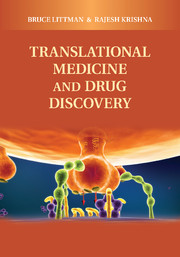Book contents
- Frontmatter
- Contents
- Contributors
- Preface
- Translational Medicine and Drug Discovery
- SECTION I TRANSLATIONAL MEDICINE: HISTORY, PRINCIPLES, AND APPLICATION IN DRUG DEVELOPMENT
- SECTION II BIOMARKERS AND PUBLIC–PRIVATE PARTNERSHIPS
- 8 BIOMARKER VALIDATION AND APPLICATION IN EARLY DRUG DEVELOPMENT: IDEA TO PROOF OF CONCEPT
- 9 IMAGING BIOMARKERS IN DRUG DEVELOPMENT: CASE STUDIES
- 10 EUROPEAN NEW SAFE AND INNOVATIVE MEDICINES INITIATIVES: HISTORY AND PROGRESS (THROUGH DECEMBER 2009)
- 11 CRITICAL PATH INSTITUTE AND THE PREDICTIVE SAFETY TESTING CONSORTIUM
- 12 THE BIOMARKERS CONSORTIUM: FACILITATING THE DEVELOPMENT AND QUALIFICATION OF NOVEL BIOMARKERS THROUGH A PRECOMPETITIVE PUBLIC–PRIVATE PARTNERSHIP
- SECTION III FUTURE DIRECTIONS
- Index
- References
10 - EUROPEAN NEW SAFE AND INNOVATIVE MEDICINES INITIATIVES: HISTORY AND PROGRESS (THROUGH DECEMBER 2009)
Published online by Cambridge University Press: 04 April 2011
- Frontmatter
- Contents
- Contributors
- Preface
- Translational Medicine and Drug Discovery
- SECTION I TRANSLATIONAL MEDICINE: HISTORY, PRINCIPLES, AND APPLICATION IN DRUG DEVELOPMENT
- SECTION II BIOMARKERS AND PUBLIC–PRIVATE PARTNERSHIPS
- 8 BIOMARKER VALIDATION AND APPLICATION IN EARLY DRUG DEVELOPMENT: IDEA TO PROOF OF CONCEPT
- 9 IMAGING BIOMARKERS IN DRUG DEVELOPMENT: CASE STUDIES
- 10 EUROPEAN NEW SAFE AND INNOVATIVE MEDICINES INITIATIVES: HISTORY AND PROGRESS (THROUGH DECEMBER 2009)
- 11 CRITICAL PATH INSTITUTE AND THE PREDICTIVE SAFETY TESTING CONSORTIUM
- 12 THE BIOMARKERS CONSORTIUM: FACILITATING THE DEVELOPMENT AND QUALIFICATION OF NOVEL BIOMARKERS THROUGH A PRECOMPETITIVE PUBLIC–PRIVATE PARTNERSHIP
- SECTION III FUTURE DIRECTIONS
- Index
- References
Summary
Introduction
On April 30, 2008, the Innovative Medicines Initiative (IMI), worth 2 billion euros, was launched in Brussels, Belgium, as a joint undertaking (JU) by the European Union (EU) and the European Federation of Pharmaceutical Industries and Associations (EFPIA). The initiative is meant to boost the funding of research of the drug development process in Europe, by addressing the key bottlenecks in the drug development value chain.
The IMI focuses on clinical safety concerns, and it is seeking to improve the efficacy of new pharmacological interventions in areas such as cancer and brain disorders, as well as inflammatory, metabolic, and infectious diseases. Projects to be funded through the IMI will also address current deficits in knowledge management and education and training for pharmaceutical research and development (R&D) in Europe. Strengthening these four pillars (efficacy, safety, information management, and education and training) is foreseen to lead to new discoveries and faster development of better therapies.
Such a program and its associated investment has a long history. In Section 10.2, we also report on the history of earlier initiatives with the involvement of many stakeholders over several years and how they have led to this successful outcome. The EU research funding system and the many European stakeholders of it should first be briefly described.
The EU Research Funding System
When the EU was established, there was also the intention to create a central funding system for research with the purpose of facilitating and supporting research collaboration between its member states.
- Type
- Chapter
- Information
- Translational Medicine and Drug Discovery , pp. 265 - 288Publisher: Cambridge University PressPrint publication year: 2011
References
- 5
- Cited by



